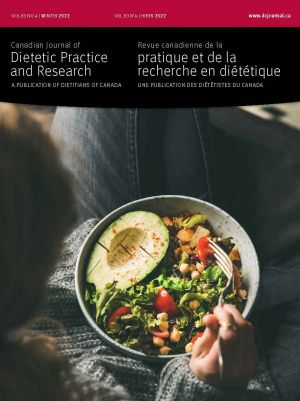Volume 80 • Number 2 • June 2019
Editor’s Message
Research
Purpose: The study aim was to evaluate a patient experience survey, the Assessment of Registered Dietitian Care Survey (ARCS), that is aligned with a nutrition counselling approach (NCA) and evidence-based chronic disease care for use in outpatient registered dietitian (RD) practice. Methods: Criterion and construct validity were examined using Pearson correlation coefficients and principal components analyses, respectively. Reliability was examined using Pearson correlations and Cronbach’s α. Acceptability was evaluated by survey response rate and readability. Kruskall–Wallis test was used to detect differences between RD scores. Results: A total of 479 survey packages were returned (46% response rate). Criterion validity indices were high (r = 0.91 and 0.94, P < 0.001) between Patient Assessment of Chronic Illness Care (PACIC) and NCA subscales, respectively, and lower with overall patient satisfaction (r = 0.63–0.65, P < 0.001). Construct validity revealed 2 factors for PACIC and NCA subscales. There was high internal reliability for the PACIC, 5As, and NCA (Cronbach’s α > 0.7) and test–retest reliability showed an adequate consistency over time (r = 0.70, P < 0.05). The tool was able to detect differences in scores between RDs (P < 0.05). Conclusions: More research is warranted to explore ceiling effects and sensitivity to intervention in similar practice settings. The NCA subscale has acceptable reliability and validity to measure patient experience of RD care.
Purpose: To evaluate whether interpretive “health” labels placed in vending machines in recreation centres represented products’ nutrient content when compared with provincial nutrition guidelines. Methods: A cross-sectional audit (November 2015 – April 2016) of 139 vending machines in recreation facilities found 525 foods and beverages in 17 machines labelled by vendors according to healthfulness. Product nutrient content was compared with provincial nutrition guideline criteria. Cross-tabulation and weighted Cohen’s kappa evaluated agreement between vendor interpretive labels and guideline ranks. Descriptive statistics evaluated how mislabelled products deviated from recommended nutrient content. Mann–Whitney tests compared nutrient content of “healthy” and “unhealthy” labelled products. Results: Almost one-third of all products were mislabelled by vendors with 72% of those labelled healthier than their actual guideline rank. Energy, total fat, sugar, and sodium contents exceeded recommended levels in one-third to one-half of mislabelled products. Overall, products labelled healthy by vendors were significantly lower in energy, sodium, and fat compared with those labelled unhealthy; however, not for all food types (e.g., bars, fruit snacks, nuts). Conclusions: For certain product categories, vendor interpretive nutrition labels poorly represented products’ nutrient content according to provincial nutrition guidelines. Dietitians may be a valuable resource to help implement nutrition guidelines to create credible interpretive product labelling systems.
Purpose: To explore the associations between full-time employment status, food skills, and diet quality of Canadian parents. Methods: A sample of Canadian parents (n = 767) were invited to complete a web-based survey that included sociodemographic variables, questions about food skills, and a validated food frequency questionnaire. Results were analyzed with linear and logistic regression models, controlling for sociodemographic variables and multiple testing. Results: After controlling for covariates and multiple testing, there were no statistically significant differences in foods skills between parents’ employment status. Time was the most reported barrier for meal preparation, regardless of work status, but was significantly greater for full-time compared with other employment status (P < 0.0001). Additionally, parents who worked full-time had lower odds of reporting food preferences or dietary restrictions (P = 0.0001) and health issues or allergies (P = 0.0003) as barriers to food preparation, compared with parents with other employment status. These results remained statistically significant even after controlling for covariates and multiple testing. Conclusions: Overall, food skills did not differ significantly between parents’ employment status. Time, however, was an important barrier for most parents, especially those working full time. To promote home-based food preparation among parents, strategies to manage time scarcity are needed.
Purpose: To examine overall usual fruit and vegetable (FV) intake and preferences among grade 5–8 students participating in the Northern Fruit and Vegetable Program (NFVP) over 3 years (2014–2016). Methods: In each year, a survey was administered 4 months into the NFVP in Northern Ontario, Canada. Results: A total of 4744 students participated (2014 = 1551; 2015 = 1617; 2016 = 1576). Overall usual FV intake did not change over the 3 years, yet preferences generally increased. FVs offered by the NFVP were rated higher on preference than those not offered (fruit P < 0.001; vegetables P < 0.005). In each year, participants were more likely to consume a higher overall usual fruit intake if they had higher preference for fruit as offered by the NFVP (all P < 0.05) as opposed to not offered by the NFVP (all P > 0.05). For vegetables, participants were more likely to consume higher overall usual vegetables if they had a higher preference for vegetables as offered (all P < 0.05) and not offered by the NFVP (all P < 0.05). Conclusions: This study documented that higher preferences for fruit (as offered) and vegetables (as offered and not offered) were associated with higher overall usual FV intakes within each of the 3 years.
Review
The quality of children’s diets has declined over the past few decades, giving rise to a variety of health-related consequences. In response to this trend, school food programs have become an increasingly effective method to support nutrition and lifelong healthy eating habits. This systematic review synthesizes current academic literature pertaining to school nutrition programs in Canada to identify existing interventions and their impacts on children’s nutritional knowledge, dietary behaviour, and food intake. The review was conducted through a search of the following databases: ERIC, Education Source, CINAHL, PubMed, SagePub, SCOPUS, EMBASE, and CBCA. Information extracted from the articles included the program objectives, intervention design and components, research evaluation, and primary outcomes. A total of 11 articles evaluating Canadian school nutrition programs were identified. The programs incorporated a variety of intervention components including policy, education, family and community involvement, and/or food provision. These multi-component interventions were positively associated with children’s development of nutrition knowledge, dietary behaviour changes, and intake of healthy foods; however, barriers associated with intervention duration, intensity, and availability of resources may have influenced the extent to which these programs impacted children’s diets and overall health.
Report
Purpose: The study objectives were to (i) describe employment outcomes among Registered Dietitians (RDs) who graduated from the University of Manitoba, (ii) test for differences in employment outcomes according to graduation year, and (iii) compare preferred area of practice and geography prior to employment with past and current employment. Methods: Graduates of the Human Nutritional Sciences program (2006–2015) were invited to participate in an online survey. Data on respondent demographics, education, and employment outcomes were collected. Results: Overall, 133 (68%) respondents self-identified as RDs. RDs who had graduated between 2006 and 2011 were significantly more likely to secure employment within 6 months post-graduation compared with RDs that graduated between 2012 and 2015. Geographically, although 56% of RDs did not wish to gain experience in rural/remote communities upon graduating, 44% of these respondents reported working part- or full-time in a rural/remote location at some point during their career. Conclusion: Findings indicate that a substantial number of RDs in Manitoba are employed in a rural or remote location despite acknowledging that it is not a preferred location. Future research is needed to explore the views and experiences of new and established RDs toward rural or remote practice, including preparedness for practice.
Purpose: This study reports on dietitian use of the Nutrition Care Process Terminology (NCPT) diagnosis of malnutrition based on Subjective Global Assessment (SGA). Methods: Nutrition assessment reports for adults in medical, surgical, and cardiac units in 13 Canadian hospitals were retrospectively examined for a 6-week period in 2014. Reports with a SGA and NCPT diagnosis were included regardless of why the patient was seen by the dietitian. Results: Of the 932 nutrition assessment reports, 857 (92%) included an SGA. Based on SGA, the prevalence of mild to moderate malnutrition (SGA B) and severe malnutrition (SGA C) was 53.4% (n = 458) and 10.0% (n = 86), respectively. When categorized as severely malnourished, the most common NCPT diagnoses were “malnutrition” (n = 55, 72.4%), “inadequate oral intake” (n = 11, 14.5%), and “inadequate protein-energy intake” (n = 10,13.1%). Among those with SGA B and C, the assignment of the NCPT malnutrition diagnosis was 19.8% (n = 95). Conclusions: Dietitians play a key role in the prevention, identification, and treatment of malnutrition in the hospitalized patient and are well positioned to take a leadership role in improving its documentation. Ongoing audits, staff support, and training regarding NCPT use may improve the application of the malnutrition diagnosis. Future research examining dietitian barriers to using the malnutrition diagnosis would be valuable.










